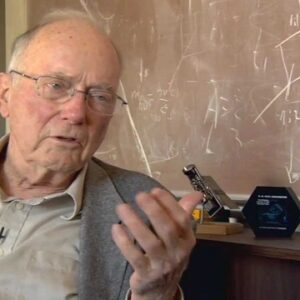Charles Hard Townes was an inventor and physicist from the United States. For his work on the theory and application of the maser, as well as other quantum electronics research involving maser devices, he was jointly awarded the Nobel Prize in Physics. This is one of the most important breakthroughs in modern experimental research, and it paved the way for the development of lasers. During WWII, he worked extensively on radar bombing and systems design, as well as conducting some preliminary radio astronomy research. Townes’ most significant contributions to the advancement of high-resolution spectroscopy of gases in the microwave region of the electromagnetic spectrum came after the war. He was a member of the team that discovered complex molecules in space for the first time and calculated the mass of the black hole at the center of the Milky Way galaxy. He was fascinated by natural history as well as science. The Richtmyer Memorial Award, the Stuart Ballantine Medal, the Wilhelm Exner Medal, the SPIE Gold Medal, and the Golden Goose Award are among the honors he has received. Charles Hard Townes was a devout Christian and a United Church of Christ member. His curiosity and strong optimism, based on Christian spiritual doctrines, gave him the courage to undertake some of the most important experimental work in Physics.
His Childhood and Adolescence
Charles Hard Townes was born in Greenville, South Carolina, on July 28, 1915. He was the son of attorney Henry Keith Townes and Ellen Sumter Townes.
He attended Greenville Public Schools and received a Bachelor of Science degree in Physics and a Bachelor of Arts degree in Modern Languages from Furman University in 1935.
Townes earned his Master of Arts in Physics from Duke University in 1937.
He received his doctorate in isotope separation and nuclear spins from the California Institute of Technology in 1939.
A Career of Charles H. Townes
Townes began his career as a technical staff member at Bell Telephone Laboratories, Inc. in 1939.
Townes became a professor at Columbia University in 1950.
He was the executive director of the Columbia Radiation Laboratory from 1950 to 1952 and the chairman of the physics department from 1952 to 1955.
In 1951, Charles Hard Townes invented a new method for producing coherent radiation beams known as Microwave Amplification by Stimulated Emission of Radiation (Microwave Amplification by Stimulated Emission of Radiation) (Maser).
Townes, James P. Gordon, and H. J. Zeiger built the first ammonia maser at Columbia University in December 1953, which produced microwave amplification at a frequency of 24.0 gigahertz.
He co-authored ‘Microwave Spectroscopy’ with A. L. Schawlow in 1955.
Townes and physicist A.L. Schawlow developed the maser technology in 1958 to produce extremely concentrated light beams, which they dubbed “laser.” In 1960, they were granted laser patents.
He was Vice President and Director of Research at the Institute for Defense Analyses in Washington, D.C. from 1959 to 1961, where he worked on national defense and foreign policy issues.
Townes served as Provost and Professor of Physics at the Massachusetts Institute of Technology from 1961 to 1967.
He became a professor of physics at the University of California, Berkeley, in 1967, and was promoted to professor emeritus in 2015.
Townes served as chairman of the NASA Science Advisory Committee for the Apollo lunar landing program from 1966 to 1970.
In 1983 he was appointed to the Pontifical Academy of Sciences and in 1994 he was elected as the Foreign Member of the Russian Academy of Sciences.
In 1995, he published his book ‘Making Waves (Masters of Modern Physics)’.
Major Works\sTownes discovered a way to produce a self-excited oscillator that would amplify signals through the use of stimulated emission. This gadget is known as Microwave Amplification by Stimulated Emission of Radiation or ‘Maser’ in short. It runs on ammonia gas and is suitable for quantum level investigations. Long-distance radar, microwave communications, and radio astronomy all use this device.
He started a radio and infrared astronomy program at the University of California that led to the discovery of complex molecules in the interstellar medium during his tenure there.
His Achievements & Awards
Townes received the Nobel Prize in Physics in 1964 for his quantum electronics research, which led to the creation of the maser. He shared the prize with two Russian scientists, N. G. Basov and Aleksandr Prokhorov, who worked on similar devices independently.
Aside from that, Townes received the Comstock Prize in Physics from the National Academy of Science (1958), the Richtmyer Memorial Award from the American Association of Physics Teachers (1959), the David Sarnoff Electronics Award from the Institute of Electrical and Electronics Engineers and the Rumford Prize from the American Academy of Arts and Sciences (1961), the National Medal of Science (1982), the Templeton Prize (2005), Nancy DeLoye Fitzroy and Roald Dahl Prize from the American Association of Physics Teachers (2012).
Townes was awarded an Honorary Doctorate of Humane Letters by the University of Redlands on May 24, 2008, and an Honorary Doctorate of Science by Texas A&M University on May 14, 2011.
Personal History and Legacy of Charles H. Townes
In 1941, Townes married Frances H. Brown, a homeless activist. Linda Rosenwein, Ellen Anderson, Carla Kessler, and Holly Townes were the couple’s four daughters, and they lived in Berkeley, California.
He died on January 27, 2015, in Oakland, California, at the age of 99.
Estimated Net Worth
Charles H. Townes’s Net worth is unknown.
Trivia
While waiting for a restaurant to open in 1951, Townes had a breakthrough idea for his maser, which he sketched out on the back of an envelope.


